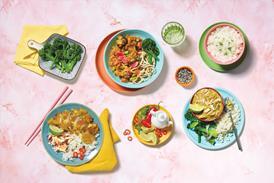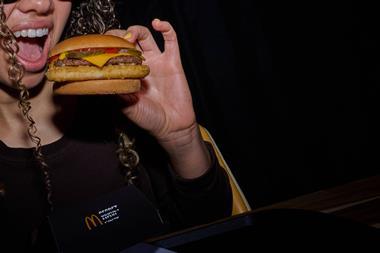José Luis Duran is not proud of the fact that the last time Carrefour delivered 6% sales growth was in 1996. Flat sales in Europe outside of France, pushing money into too many global markets and 'promotional neglect' have all been blamed for the decline in fortunes of the world's second biggest retailer. Now, however, he believes Carrefour has hit on a new business model that will get sales moving from the bottom left to top right once more. He outlined some of the details at IGD's Global Retailing conference on Tuesday.
At first glance, there's nothing particularly innovative about it. New stores will create 16 million sq ft of extra space every year - double that previously and a fairly obvious way to boost sales. But this space will be better focused. Carrefour recently divested its Korea business and will pay greater attention to key markets such as Turkey, where four new hypermarkets will be built each year between now and 2008. Italy will see eight new hypermarkets a year, Brazil will get 13 and China 23. Indeed, there are plans to open 100 new hypermarkets around the world every year for the next three years.
Although Duran is keen to play the emerging markets - Carrefour already has 78 stores in China and sales there rose 25% to £1.3bn last year - it is Europe, where 85% of Carrefour's E74.5bn (£51bn) sales are made, that will be his more immediate priority. He has not been scared to sanction drastic changes. Where new stores are concerned, the Carrefour name will no longer hang only above warehouse-like buildings often of 75,000 sq ft - a Carrefour Express format will be developed and rolled out. Duran admits: "We have probably been too rigid in the past - there were too many taboos. A hypermarket had to be a box of 7,000 sq m (75,000 sq ft) otherwise it didn't merit the name Carrefour. We've been doing tests in Spain to see how to fill in the gap between 4,000 (43,000 sq ft) and 7,000 sq m to meet customer needs and find growth opportunities, and the tests showed a Carrefour Express format can be successful."
These will replace Carrefour's 143 Champion supermarkets in Spain, which were losing the company E40m. They will carry 6,700 SKUs, a third of which will be own-label lines. There will be no price differential with the hypermarkets. Duran says Carrefour Express will be rolled out to Brazil in the next few months too, and you can also expect to see Italy and Belgium, Carrefour's two worst performing European markets in Q1, to get an Express makeover.
Carrefour Express is part of a multi-format strategy. The Spanish trials included Carrefour-branded mini hypermarkets of 32,000-43,000 sq ft, Carrefour Express soft discount supermarkets of 16,000 sq ft and MaxiDia discount stores, which only sell private label products. The results were sales uplifts of 30% in every format. Now each format is being redefined. Discount stores, previously a maximum 8,600 sq ft, will be upped to 13,000 sq ft. Supermarkets, previously 8,600-43,000 sq ft, will be run as Carrefour Expresses up to 21,500 sq ft or other supermarket brands between 21,500 and 32,000 sq ft. Hyper- markets, previously a maximum 75,000 sq ft, will be capped at 43,000 sq ft but run as mini hypermarkets or classic hypermarkets.
The new strategy encompasses a more customer-focused approach to selling, says Duran. "We have two words now: customer and growth. Before we had too many priorities, we were allocating capex to too many markets at the same time, and we've been losing market share in France for five years in a row. What we have now looks basic and simple, but it's what we'll be putting in place in years to come."
Price is key, but there are four other "building blocks" to Carrefour's model: choice, service, reliability and reward. Choice comes by increasing SKUs. Since September last year 15% more SKUs are on offer. Service will be improved with more shop-floor staff. Reliability will be addressed by pushing the brand through 1,000 new own-label lines before the end of this year. And loyalty will be rewarded with promotions.
Non-food relies heavily on promotions. When Carrefour stopped sending out promotional leaflets for two weeks last year, sales of non-food items dropped 6%. Now, Duran wants a more customer-oriented stance and, although he admits he wants to be a generalist rather than a champion in a particular category, he says some categories will be sacrificed in order to better manage their assortment.
All this will hopefully turn into growth of 4-5% this year. Not quite the 6% of a decade ago, but a juggernaut often takes some time to turn a corner.n
At first glance, there's nothing particularly innovative about it. New stores will create 16 million sq ft of extra space every year - double that previously and a fairly obvious way to boost sales. But this space will be better focused. Carrefour recently divested its Korea business and will pay greater attention to key markets such as Turkey, where four new hypermarkets will be built each year between now and 2008. Italy will see eight new hypermarkets a year, Brazil will get 13 and China 23. Indeed, there are plans to open 100 new hypermarkets around the world every year for the next three years.
Although Duran is keen to play the emerging markets - Carrefour already has 78 stores in China and sales there rose 25% to £1.3bn last year - it is Europe, where 85% of Carrefour's E74.5bn (£51bn) sales are made, that will be his more immediate priority. He has not been scared to sanction drastic changes. Where new stores are concerned, the Carrefour name will no longer hang only above warehouse-like buildings often of 75,000 sq ft - a Carrefour Express format will be developed and rolled out. Duran admits: "We have probably been too rigid in the past - there were too many taboos. A hypermarket had to be a box of 7,000 sq m (75,000 sq ft) otherwise it didn't merit the name Carrefour. We've been doing tests in Spain to see how to fill in the gap between 4,000 (43,000 sq ft) and 7,000 sq m to meet customer needs and find growth opportunities, and the tests showed a Carrefour Express format can be successful."
These will replace Carrefour's 143 Champion supermarkets in Spain, which were losing the company E40m. They will carry 6,700 SKUs, a third of which will be own-label lines. There will be no price differential with the hypermarkets. Duran says Carrefour Express will be rolled out to Brazil in the next few months too, and you can also expect to see Italy and Belgium, Carrefour's two worst performing European markets in Q1, to get an Express makeover.
Carrefour Express is part of a multi-format strategy. The Spanish trials included Carrefour-branded mini hypermarkets of 32,000-43,000 sq ft, Carrefour Express soft discount supermarkets of 16,000 sq ft and MaxiDia discount stores, which only sell private label products. The results were sales uplifts of 30% in every format. Now each format is being redefined. Discount stores, previously a maximum 8,600 sq ft, will be upped to 13,000 sq ft. Supermarkets, previously 8,600-43,000 sq ft, will be run as Carrefour Expresses up to 21,500 sq ft or other supermarket brands between 21,500 and 32,000 sq ft. Hyper- markets, previously a maximum 75,000 sq ft, will be capped at 43,000 sq ft but run as mini hypermarkets or classic hypermarkets.
The new strategy encompasses a more customer-focused approach to selling, says Duran. "We have two words now: customer and growth. Before we had too many priorities, we were allocating capex to too many markets at the same time, and we've been losing market share in France for five years in a row. What we have now looks basic and simple, but it's what we'll be putting in place in years to come."
Price is key, but there are four other "building blocks" to Carrefour's model: choice, service, reliability and reward. Choice comes by increasing SKUs. Since September last year 15% more SKUs are on offer. Service will be improved with more shop-floor staff. Reliability will be addressed by pushing the brand through 1,000 new own-label lines before the end of this year. And loyalty will be rewarded with promotions.
Non-food relies heavily on promotions. When Carrefour stopped sending out promotional leaflets for two weeks last year, sales of non-food items dropped 6%. Now, Duran wants a more customer-oriented stance and, although he admits he wants to be a generalist rather than a champion in a particular category, he says some categories will be sacrificed in order to better manage their assortment.
All this will hopefully turn into growth of 4-5% this year. Not quite the 6% of a decade ago, but a juggernaut often takes some time to turn a corner.n














No comments yet